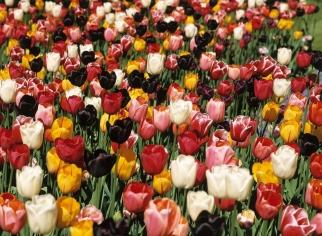














TOWNSHIP MANAGER
William F. Martin
Julie Gosse, Chair
Matthew Holt, Vice-chair
KS Bhaskar
Tredyffrin Township Building
Phone.........................................610-644-1400
Fax..............................................610-993-9186
Joseph DiRocco, CPA
ASSISTANT TOWNSHIP MANAGER & FINANCE DIRECTOR DIRECTOR OF PLANNING AND ZONING
Erin McPherson
TOWNSHIP ENGINEER
Stephen Burgo, P.E.
PUBLIC WORKS DIRECTOR
Darin Fitzgerald
Mark Freed
Sharon Humble
David Miller
Murph Wysocki
Environmental Advisory Council Historical Commission Library Board of Trustees Municipal Authority Parks & Recreation Board
Pension Trustees
Website..............................www.tredyffrin.org

Email ........................tredyffrin@tredyffrin.org
Tredyffrin Township Police Department
Emergency..................................................
911
Business .....................................610-644-3221
Dispatch .....................................610-647-1440
Tredyffrin Township Public Works Department
Business .....................................610-408-3620
Fire and Ambulance
Berwyn Fire Company ................................911
Gabrielle Ignarri
PUBLIC INFORMATION SPECIALIST DIRECTOR OF LIBRARIES
Mallory Hoffman
SUPERINTENDENT OF POLICE
T. Michael Beaty
TOWNSHIP SOLICITOR
Gawthrop Greenwood, PC
Planning Commission Traffic Committee Zoning Hearing Board
Newsletter Staff
Paoli Fire Company.....................................911
Radnor Fire Company.................................911
Malvern Fire Department ..........................911
Tredyffrin Township Libraries
Strafford.....................................610-688-7092
Paoli ...........................................610-296-7996
Tredyffrin/Easttown School District
Business .....................................610-240-1900
Emergency Closing Number .......................854
th During your participation in and attendance at Township events and activities like the Summer Concert Series, 4 of July Celebration, or Community Day, you may be filmed, videotaped, and/or photographed by Township Staff. Your attendance serves as permission for use of your image by the Township (for example: in newsletters or on the Township website).
PLEASE NOTE:

BOARD OF SUPERVISORS
7 PM - Keene Hall
May 22
June 20
July 17
August 21
September 18
October 10 & 23
November 1 & 13
December 4 & 18
ENVIRONMENTAL ADVISORY COUNCIL
7 PM - Keene Hall
May 23
June 27
August 22
September 26
October 24
November 28
HISTORICAL COMMISSION
7 PM - Keene Hall
May 11
June 8
July 13
September 14
October 12
November 9
December 14 (Community Room)
LIBRARY BOARD OF TRUSTEES
7:30 PM - Tredyffrin Public Library
May 25 (T)
June 22 (P)
July 27 (T)
August 24 (T)
September 28 (T)
October 26 (P)
December 7 (T)
MUNICIPAL AUTHORITY
7 PM - Keene Hall
July 11
October 17
PARK & RECREATION BOARD
7 PM - Keene Hall
May 10
June 14
July 12
September 13
October 11
November 8
PENSION TRUSTEES
7:30 AM - Paul Olson Conference Room
February 8
May 10
August 9
November 8
PLANNING COMMISSION
7 PM - Keene Hall
May 18
June 15
July 20
August 17
September 21
October 19
November 16
December 21
TRAFFIC COMMITTEE
7:30 AM - Keene Hall
June 21
September 20
December 20
ZONING HEARING BOARD
7 PM - Keene Hall
February 23
March 23
April 27
May 25
June 22
July 27
August 24
September 28
October 26
November 15
December 14
Memorial Day......................May 29
Juneteenth Independence Day........ ............................................
June 19
Independence Day .................July 4
Labor Day .............................Sept. 4
Columbus Day/
Indigenous Peoples Day .......Oct. 9
Veterans' Day.......................Nov. 10
Thanksgiving Day.................Nov. 23
Day after Thanksgiving ........Nov. 24
Christmas Day
Dec. 25







FOOD TRUCKS, LIVE MUSIC, & FIREWORKS


Music By CHESTER COUNTY CONCERT BAND
Park opens to the public at 5 PM. Band begins at 7:15 PM. Fireworks begin after sundown. 69 DARBY ROAD, PAOLI ALL ARE WELCOME!




1-4 PM








JUN
JUN 22
JUN 29
JUL 13
JUL 20
JUL 27
SEP 07
THURSDAYS AT 7PM
*ALL SHOWS ARE WEATHER PERMITTING*
Summer concerts are free to attend. Kona Ice is at each concert if you wish to purchase water ice to enjoy while you are listening to the band. Additionally, this year, local breweries will be there: June 15 - Wills 'n Bills; June 22 - Locust Lane Craft Brewery; June 29 - LaCabra Brewery; July 13 - Locust Lane Craft Brewery; July 20 - Locust Lane Craft Brewery; July 27 - LaCabra Brewery, and September 7 - Wills 'n Bills.








Monday - Friday
Weekly Sessions from June 20 - July 28, 9 AM - Noon (No Camp on July 4)
Wilson Farm Park
Wednesdays, (8 weeks)
June 21 - August 9
4:30 - 6:30 PM
Select from five 30-minute sessions
Fee: $152
Thursdays, (8 weeks)
June 22 - August 10
5 - 6:30 PM
Select from three 30-minute sessions
Fee: $152
Saturdays, (8 weeks)
June 24 - August 12
8:45 - 11:30 AM
Select from six 30-minute sessions
Fee: $152
Teegarden Multi-Use Court
Universal Rackets
Wednesdays, (6 weeks)
May 31 - July 5
Beginners: 5 - 6:30 PM
Intermediate: 6:30 - 8 PM
Fee: $210
Fee: Tredyffrin Township
Resident - $100/week/child
th (4 of July week - $85/child)
Non-Tredyffrin Township
Resident - $125/week/child
th (4 of July week - $105/child)
Wednesdays, (6 weeks)
September 6 - October 11
Beginners: 3:30 - 5 PM
Intermediate: 5 - 6:30 PM
Fee: $210
Teegarden Tennis Courts
Universal Rackets
Sundays, (6 weeks)
June 25 - July 30
Beginners: 9 - 10:30 AM
Begin./Intermediate: 10:30 AM - 12 PM
Intermediate/Advanced: 121:30 PM
Fee: $210
Sundays, (6 weeks)
October 1 - November 5
Beginners: 12 - 1:30 PM
Intermediate: 1:30 - 3 PM
Advanced: 3 - 4:30 PM
Fee: $210
Little Laxers Lacrosse
Wilson Farm Park
June 19 - 23
9 AM - 12 PM
Fee: $185

On March 30, Township Engineer, Stephen Burgo, P.E., '95 CE, '99 MSCE, was presented The Alumni Award for Professional Achievement which was instituted in 1984 by the College of Engineering at Villanova University. This award recognizes contributions to technology through substantial achievements in marketing, management, or entrepreneurship, as well as achievements in strictly technical fields. Such accomplishments reflect favorably on the University. Congratulations!

Registration is active for Summer Day Camp, Half Day Camp for 6 weeks for children ages 3½ to 12. Sign up for all six weeks or just one and enjoy daily activities including crafts, scavenger hunts, talent shows, music, relay games, water activities, large group games, and a surprise special activity each week.
Registration is required…Visit the Township website to sign up! Questions: Call 610-408-3626 or e-mail Hmallory@tredyffrin.org
Teegarden Park
June 20 - August 3
Fee: $95/resident; $110/nonresident
Teegarden Park
Boys
June 19 - 23
June 26 - 30
July 3 - 7 (no camp on July 4)
July 10 - 14
Girls
July 17 - 21
July 24 - 28
Fee: $115/resident; $410 for all four weeks
$125/non-resident; $450 for all four weeks
Strafford Park
Universal Rackets
For ages 6 - 14
Monday - Thursday, July 10 - 13
9 - 11 AM
Fee: $320
Monday - Thursday, July 24 - 27
9 - 11 AM
Fee: $320
Monday - Thursday, Aug. 7 - 10
9 - 11 AM
Fee: $320

Strafford Park
Universal Rackets
For Ages 18 and up
Monday - Thursday, July 24 - 27
6:30 - 8:30 PM
Fee: $320
Wilson Farm Park
Monday - Friday, August 14 - 18
9 AM - Noon, or
9 AM - 2 PM
Fee: $225/Half Day $375/Full Day
Monday - Friday, August 21 - 25
9 AM - Noon, or
9 AM - 2 PM
Fee: $225/Half Day $375/Full Day




Stephen Burgo, P.E., Township Engineer
The Board of Supervisors received a presentation on the Pugh Road Culvert Replacement Project which has closed the road since October. The project included installation of a pre-cast concrete culvert, headwall, endwalls, and a retaining wall. Rip-rap stone protection was installed and the culvert was backfilled. The original guiderail was replaced. The roadway was restored and repaved, line striping done, and landscape around the area restored. A residential driveway that was moved was switched back to its original location. Guiderail signage and pavement were done. Pugh Road was reopened May 1.









Conestoga High School's Asian American Culture Club celebrated the Lunar New Year at the end of January. To kickoff the Lunar New Year celebration, the Club held a Lion dance on Friday, January 20, during 8th period. On Tuesday, January 24, the Club held a potluck to celebrate as a club afterschool and were joined by some staff members. As part of the celebration, students performed a dance, played cultural games, shared cultural experiences, and built community with one another.This year, Lunar New Year fell on Sunday January 22. Most of Asia is celebrating the year of the Rabbit; however, in Vietnam, it is the year of the Cat. Lunar New Year marks the beginning of a new year based on the Chinese lunar calendar. While this holiday is based off the Chinese lunar calendar, it is celebrated across Asia and is observed by people of
students at Conestoga who demonstrate character through the maintenance of integrity and the balance of respect and responsibility. The MLK Champion of Equity Award was presented to students, staff, and community members for their compassionate and courageous efforts to create a diverse community and to bring about systemic change aimed at promoting justice and equity. In addition, the AASU hosted its inaugural “One 'Stoga, One Dream” Symposium on January 27. This year, members discussed the School District's “School Fight” of 1932-34, learned about the lived experiences of current AASU members, and concluded with a conversation of ways to build a more inclusive and unified school community.
elementary level. Valley Forge will continue to be significantly larger in student population than the other four elementary schools, while two of the remaining four schools are projected to fall below the target population of 450-500 students.
On January 27, the African American Student Union (AASU) at the High School hosted its inaugural Spirit of Dr. Martin Luther King, Jr. Awards. This program honors students, school staff, and community members for making a positive difference in their schools and the greater
During February and March, Dr. Richard Gusick, Superintendent of Schools, and Dr. Wendy Towle, Director of Curriculum, Instruction, Staff Development and Planning, held five community presentations to share an update on TESD elementary enrollment trends and the impact on facilities utilization. Community members who were unable to attend the presentation can view a recording of the presentation and additional information at www.tesd.net/enrollment
Enrollment Increases at the Elementary Level
When the student population increases at an individual elementary school, it impacts how the classroom space is used in the building. At the point of 574 students or greater, the potential exists for a significant impact on the program delivery and additional resources are required. Over the next 10 years, projections indicate that Valley Forge Elementary School will be consistently over 574 students each year, with two other schools approaching 500.In addition, there has been a significant change in programming that has taken place in special education since 2012, and additional classroom space has been needed to accommodate these programs. Since 2017, TESD has needed 10 additional elementary classrooms to meet the needs of our special education students. Projecting forward over the next five years, four additional classrooms will be needed for special education programming beyond what is utilized this year. While the District is able to successfully deliver its educational programs even when student enrollment approaches the higher end of the range, additional resources, special planning, and changes to common area utilization are needed to accommodate a larger student population.
TESD is exploring strategies to respond to the increasing elementary enrollment and disparity among the student population at its elementary schools:
The MLK Heart of Service Award was presented to students, staff, community members and/or groups making a significant impact on the community through volunteering and/or going above and beyond job responsibilities.The MLK Character Award was presented to

Historically, elementary school enrollment has steadily increased since 1995 with the exception of a dip in 2020, potentially as a result of the pandemic. Projections indicate that enrollment numbers will be restored to pre-pandemic levels in the near future. In addition to overall enrollment increases, the District's elementary school student populations have been historically inconsistent and the largest and smallest schools often change. These numbers shift from one year to the next due to small changes in the region and other factors. In 2023, Valley Forge Elementary School has the highest enrollment at 573 and Devon Elementary School has the lowest at 375; however, the most populous school has changed several times over the last few decades. Enrollment projections indicate that over the next 10 years, there will continue to be disparity in the student population at the
1. Monitor enrollment and maintain status quo.
2. Maximize school footprints. Consider every space available and maximizing its use.
3. Add on or expand existing elementary schools.
4. Redistrict to rebalance school populations.
5. Build a new school, which would also provide additional space for full-day kindergarten implementation.
TESD families and community members are encouraged to learn more about elementary enrollment and facilities utilization by reviewing the presentation at www.tesd.net/enrollment. In addition, the TESD community is invited to share feedback or comments about the elementary enrollment presentation by using an open comment email inbox at elementaryenrollment@tesd.net



volunteers in school buildings while alerting school personnel to the presence of individuals who appear on the sex offender database.
discussion about different scenarios involving threats.
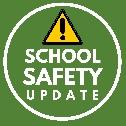
Over the past two years, the T/E School District has added new tools to enhance safety and security at our school buildings.
- This fall, the School District began using the Raptor Visitor Management System to enhance school entrance protocols. The new visitor check-in system provides a consistent method to monitor visitors and

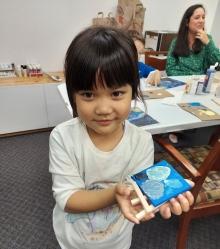
During the second half of the 2022-2023 school year, the District has been conducting emergency preparedness trainings for all school staff. These trainings are designed to enhance readiness for the unexpected. In cooperation with local law enforcement offices, we are implementing 'slow motion' lockdown drills with small groups consisting of staff, a school administrator, and a police officer. These small groups then walk through a lockdown drill with frequent pauses for discussion and questions. In their small groups, staff are able to pose questions related to their classroom or workspace and engage in
The School District has a District Safety Committee that regularly reviews best practices for school safety and consults with local law enforcement, mental health professionals, and nationally recognized groups such as Safe and Sound Schools, the National Association of School Psychologists, and the National Association of School Resource Officers. In addition, we have a District Safety Plan and buildinglevel safety plans that address prevention, intervention, response to incidents that compromise school safety, and security and postvention. The District encourages families to have their own family emergency plan and be prepared for emergencies that may happen beyond the school day.
Newly arrived grandparents bring their grandchildren to storytime and learn English along with them. One story-time mother hears another speaking her native language and they are soon arranging a playdate for their children. Parents in the local Russian-speakers' Facebook Group get together in real life to attend story-time.
New immigrants enliven and enrich the Library environment for other patrons and the staff. A Russian-speaking boy partners with a native English speaker at LEGO club and soon the two are learning words in each other's languages. The Children's Librarian invites mothers to suggest favorite titles in their home languages to add to the Library's collection.
Across the borders of language and culture, new immigrants find community at Tredyffrin Township's Public Libraries. Parents who speak Russian, Ukrainian, Japanese, Chinese, Urdu, Tamil, Spanish, or German can find books in their native language to read to their children. And beyond these particular books and these particular languages, Library programs and activities provide a welcoming environment for all.


Children's Department programs and displays highlight holidays from a variety of ethnic and religious traditions, including Ramadan, Cinco de Mayo, Passover, Lunar New Year, Diwali, and St. Patrick's Day. Program attendees learn about the things we celebrate in common—the changing seasons, lifecycle events, and historic occasions—and the special customs that lend significance to these celebrations.
Thanks to a generous Library donor, the Libraries now have Citizenship Corners for newcomers, featuring the Citizenship Toolkit, provided by the Institute of Museum and Library Services. The toolkit includes copies of the Declaration of Independence and the Constitution, Welcome to the United States: A Guide for New Immigrants, and flashcards and study guides for the Naturalization Test. New resources are being added, so the Citizenship Corners will also include items, such as pocket study guides in several languages and multimedia materials describing citizenship and the history of the United States. One Citizenship Toolkit is always available in the Library for reference, and each Library also has an additional Citizenship Toolkit that is available for checkout.
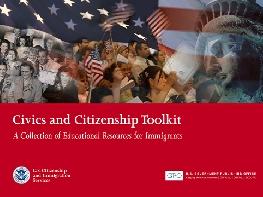








When you talk about recycling, it's likely that plastic is the material on everyone's minds. “Plastic is confusing!” (Yes, it is!) “Do we really need it?” (Yes and no)
But paper? Not so much. Why not? Because paper is one of the easiest materials to recycle, and it has a long history of recyclability in the US (1600's by many accounts). Recycling one ton of paper saves 3.3 cubic yards of our precious 1 landfill space!
Paper can be recycled 5-7 times. The longer the paper's fibers, the more times it can be recycled into a new product before it loses its integrity. Today's copy paper can be next week's newspaper, then next month's paper towels.
Using recovered paper in mills is more economical than using virgin fiber. The process does not require extreme heat for melting, as it does for plastic, glass, and metals. Energy costs are a concern, however most of the mills in our eastern region have very efficient systems. Philadelphia's Newman Mill, for example, has a closed loop system that co-generates, producing its own steam and electricity Using 100% recycled feedstock, Newman Paper manufactures chip board used in the making of packaging, gameboards, puzzles, candy boxes, book covers and many other everyday products.
About 80% of US paper mills depend on used paper to manufacture some or all 1 their products. Overall, the fiber mill industry is healthy, there is plenty of recyclable fiber feedstock available and trucking and labor are finally finding some stabilization.
BINS? Clean loads are essential! Unsoiled junk mail, magazines, newspaper, office paper, flattened cereal boxes/paperboard and corrugated, and CLEAN pizza boxes (NO FOOD OR GREASE!).
Not all paper collected for recycling in Chester County ends up at the same mill. Each has their own unique limits on what specific fibers they need and contamination levels.

Always check with your municipality or private recycling hauler to know what is acceptable.
Let's be Trash Smart. Appreciate your paper when you use it and love it enough to easily recycle it!`
1 ISRI 4/5/23, https://www.isri.org/recycled-commodities/paper
 By Patti Lynn Recycling Resources Manager
By Patti Lynn Recycling Resources Manager
What do batteries and plastic containers have in common? Both are ubiquitous and confusing to recyclers, having multiple chemistries in multiple products. Manufacturing of batteries will increase over 400% from 2020-2025. From button cells to embedded ones, batteries are smaller, lighter, cheaper, but more energydense than ever before. Their power can make them dangerous to manage, even if you think they have lost their charge. A recent fire in a York County recycling facility is believed to have started with a lithium-ion battery mixed with cardboard.
Batteries are either primary (one and done), or they are rechargeable.



Both types can be recycled, but they do NOT go in your recycling bin OR your trash bin.
Alkaline batteries (AA, AAA, etc.) are the ONLY ones that can safely go in trash. Remember - a spent battery can still have a charge. Lithium-ion batteries are flammable if they are punctured. It is unsafe to remove a LI-ion battery. Before battery drop off, tape the terminals, or put the same type of batteries (all NiCad, e.g.) in a plastic bag. View the CCSWA's safety at https://www.youtube.com/watch?v=gpwL 5vBgDY8
Otherwise, bring them to a Home Depot or Lowes (check online), or register for a county Household Hazardous Waste event.
Wouldn't it be helpful to have a universal labeling system for common household batteries so consumers will know how to manage them at end-of-life? Batteries are getting recycled for their component metals, thereby reducing extraction needed from the earth. That is a good thing. Please be responsible with your batteries!
Electric bikes use lithium batteries that may be recharged up to 1,000 times. Eventually, we will be hearing about the need to "dispose" of them. Additionally, with EV demand up, it is reasonable to think that more infrastructure will be needed to handle these "high watt hour" (>300 hrs.) batteries, automatically deemed "hazardous". But, there is a solution for bike batteries: the Call2Recycle product stewardship organization that recycles batteries has partnered with People for Bikes to collect bike batteries at retail bike shops.
If there is a bicycle shop in your community, please let them know about this program. Use the website https://www.peopleforbikes.org/ to find area bike shops who are partners in this program.

After a quiet winter, the Tredyffrin Historic Preservation Trust is excited to share its upcoming events. On Sunday, April 2nd, the Trust kicked off the second season of the Jones Log Barn Living History Center. The barn is unique, not only for its age and its contributions to Pennsylvania history, but also for its architecture. Located at 297 Adams Drive in Chesterbrook, the Living History Center is a special one-of-a-kind log barn museum and is open to the public, free of charge each Sunday, April through October. As a special treat this year, the Easter Bunny was “in the barn” for the opening day of the Living History Center, creating a perfect photo opportunity for children and parents. There is nothing better than a bunny in the barn!
by Pattye Benson, President, Tredyffrin Historic Preservation TrustWe are thrilled that post-pandemic, the Tredyffrin Easttown School District has returned to student field trips—which includes visiting the historic Duportail House, Federal Barn, and our newly reconstructed Jones Log Barn Living History Center. Third graders in TESD study local history; and we are eager to greet Devon Elementary and New Eagle Elementary students this spring as part of the curriculum. Providing morning and afternoon programs for each school, the students learn about the history of General Duportail and his house, the reconstruction and history of the Jones Log Barn, colonial dance and music, and participate in quiltmaking. The Trust has enjoyed a longstanding relationship with the School District, and we look forward to sharing local history with the students.
The Trust has returned to its spring and fall lecture series. All lectures are at 7:30 PM (reception 7 PM). The following is a list of dates and speakers for the spring/summer. In addition to tickets, specific details about the individual lectures are available at www.tredyffrinhistory.org.
Have you noticed? In front of the Old Eagle School in Strafford and the adjacent Cemetery on Old Eagle School Road you will find an “America 250 Patriots Marker.” The Marker was unveiled on November 6, th 2022. This is the 7 marker placed by the Daughters of the American Revolution (DAR) in Pennsylvania. The markers th commemorate the 250 anniversary of America's founding in 1776 to be celebrated in 2026.
“The members of the National Society Daughters of the American Revolution dedicated this marker in grateful recognition of the men and women who achieved American Independence,” said State DAR Regent Marguerite Fitsch. “May this marker help keep their stories alive. We especially remember all those buried in the Old Eagle School Cemetery. Their vision, courage, and sacrifices are not forgotten.”
Early in 2022, the Jeptha Abbott Chapter of the National Society Daughters of the American Revolution approached Old Eagle Trustee President Ashley White regarding the significance of the Cemetery. There are several Revolutionary War soldiers buried there and even a few with headstones marked as “unknown.”
It should be noted that the base for this grand marker was put into place as an Eagle Scout project by William Cook of the Paoli 1 Scout Troop. The Troop provided Color Guard services, flag bearers, and installation of the Plaque.
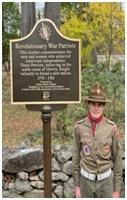 by Pearl M. Nudy, Historical Commission Member
by Pearl M. Nudy, Historical Commission Member

Tuesday, June 7 at Jenkins Arboretum: Camp Meetings & Chautauquas—

th America's 19 Century Back to Nature Movement with architectural historian and guest lecturer Robert Wise
Wednesday, July 26 at Duportail House: Duportail—A Founder Forgotten with guest lecturer and Tredyffrin resident James McKinley
The Trust is excited to share the Jones Log Barn Living History Center with the community. We encourage you to visit on Sunday afternoons from 1 - 3 PM through October. As supporters of local history, we would also welcome you to attend a lecture.
For historic preservation to matter, and for our local history to be meaningful, it needs to be supported. A community that respects its history respects itself. How can you help? There are many ways that the Trust seeks volunteers do you have an interest in local history and time to help? Please call (610)644-6759 for further information.
Nation's Semiquincentennial will be celebrated in 2026. This was the first event in our Township to prepare for that great celebration. Rob Williams, Chair of the Township Historical Commission, has said th that for Tredyffrin Township, the 250 celebration will be about preserving the history of a Township steeped in the rich history of our Nation.
The Historical Commission has started planning for 2026-2027 commemorations within the Township. The community will be invited to join and lead efforts to promote historic preservation through education, local events, and other outreach incentives.
According to DAR Chapter Regent Teri Fischer, the last time a marker of this nature was placed by our Chapter was 90 years ago in 1932 at the Ye Olde Buck th Tavern in Ardmore. The 8 DAR America 250 Patriot Marker was installed at Historic Waynesborough in Easttown on March 26, 2023.
On December 17, 2022, Wreaths Across America sponsored by Jeptha Abbott DAR placed a wreath at every grave site in the Old Eagle Cemetery in a beautiful ceremony in which every branch of the military was recognized and represented.
Why is this so important since it took place last year?
As most of you know, America and the Commonwealth of Pennsylvania are th approaching their 250 birthday: our
The Township is expanding volunteer involvement by opening Commission associate memberships. Not everyone has the time to serve on a Board. But if you are interested in becoming a part of what very well may be dubbed the all-time greatest birthday party this Country has ever known, an Historical Commission Associate Membership is for you. Also, you can volunteer for upcoming events.


Did you know that there are “behind-thescenes” people from the Township who serve on authorities, boards and commissions who willingly give of their time, expertise, and energy in service to Tredyffrin? Many of the folks who serve are volunteers.They are your neighbors, parents of your children's friends, and members of your community. You are familiar with the Board of Supervisors, the Township Manager and his Department Heads, the Superintendent of Police and his police department, the Public Works crews who you see out on the roads in the winter and in the parks in the nice weather, and the administrative staff who help you every day. Let's take a look at these ABC's in Tredyffrin.
Members of the Board of Supervisors are elected officials and serve four-year terms and they are the Township's decisionmaking body of seven elected officials.Supervisors establish Township policy, initiate and adopt ordinances and resolutions relating to Township business, determine the rates for both real estate and other taxes they are empowered to use, and set both capital and operating budgets. Supervisors provide for police and fire protection, planning and zoning, street maintenance and snow removal, sewers, libraries, parks, and recreation, and regulate land use development and building construction. Supervisors also appoint key Township officials and residents to the Authorities, Board and Commissions.

The seven members of the Environmental Advisory Council (EAC) serve three-year terms and are dedicated to exploring and promoting environmental initiatives in the
Township. The EACworks at the direction of the Board of Supervisors and as an extension ofstaff to research environmental issues and funding sources; to advise staff and supervisors; to sponsor environmental education; to partner with residents, outside agencies, and organizations with similar interests; and to coordinate environmental projects.
The seven members of the Historical Commission (HC) serve three-year terms and advise the Township on matters concerning the preservation of historic resources.
The nine members of the Library Board of Trustees serve three-year terms. Responsibilities of the Board include fundraising for operations, overseeing the annual budget, determining policy, and working to help improve library services and resources at both the Tredyffrin Public Library and the Paoli Library.
The seven members of the Municipal Authority serve five-year terms and the purpose of the Authority is to provide funding for sanitary sewer and highway projects in the Township through the sale of Municipal Bonds. The Municipal Authority owns all the sanitary sewer facilities and leases them to the Township.


The seven members of the Park and Recreation Board serve three-year terms. The Board oversees the acquisition, development, and use of park sites and supervises park activities. Their mission is to enhance the quality of life for residents of all ages through parks, recreation programs, and open space preservation.
The three Trustees oversee the management of the Township's pension plans.
The seven members of the Planning Commission serve four-year terms and are authorized to prepare, update, and oversee implementation of the Comprehensive Plan, Subdivision and Land Development Ordinance, and Zoning Ordinance, and to review land development and subdivision applications. Land development decisions by the Planning Commission are final, while the Board of Supervisors has final approval authority on all subdivision applications. Regular meetings, usually held on the third Thursday of the month, are formal meetings where applications are first heard, and decisions or recommendations are made. The public is welcome to attend and comment on any matter on the agenda.
The members of the Zoning Hearing Board serve three-year terms and consist of three members and three alternate members. Appeals for relief from decisions of the Zoning Officer and/or requirements in the Zoning Ordinance are handled by the Zoning Hearing Board. This is a quasijudicial body whose decisions are not subject to the approval of the supervisors. Zoning Hearing Board meetings, which are open to the public, are usually held on the fourth Thursday of the month.

There are open positions on the Park & Recreation Board, the Zoning Hearing Board (alternate positions), and the Historical Commission. If you are interested in serving, please send a letter of interest and a brief resume to tredyffrin@tredyffrin.org










Why they are important for birds and should be incorporated into your yard
 by Jennifer Cox, EAC Member
by Jennifer Cox, EAC Member
The Township is distinctive for its woodlands. Whether in a preserve, park or residential backyard, you are never far from woods. Although often unnoticed in woodlands, decaying wood and leaves are integral to the ecology. For example, snags and downed wood can provide important food and shelter for woodland birds that visit your yard.

Snags: Birds use snags of all sizes. Any snag that you can safely and comfortably leave on your property will benefit wildlife. Larger snags: Pileated woodpeckers, northern flickers and owls require larger snags (taller, broader dead trees) for nest cavities. Note: Dead trees that pose a risk to structures should be removed, but some can be cut to a safe height and still provide opportunities for larger birds to create nest cavities that will eventually be used by cavity-nesting birds. Smaller snags: Chickadees, titmice, wrens, nuthatches, and downy woodpeckers can use smaller snags (such as dead saplings) or the dead branches of larger trees for nest cavities.
Brush Piles: The best brush piles for
Snags are standing trees that are dead or dying. Snags provide a number of important benefits to wildlife. As a tree dies, its bark loosens and forms bark cavities. These cavities are used for roosting by forest-dwelling bats and as nest sites by small forest birds called brown creepers. Insects, a valuable food source for many species, are abundant in snags. A wide variety of birds (including flycatchers, raptors, and songbirds) also use snags as hunting and singing perches.
Tree cavities are holes that have been excavated in snags, often by woodpeckers. These holes are used for shelter and nesting by many species including owls, wood ducks, chickadees, titmice, nuthatches, wrens, bluebirds, and woodpeckers. There are over 35 bird species found in Pennsylvania that require cavities for nesting. Consider leaving some snags on your property to benefit wildlife.

Dead wood is also important for wildlife habitat. As logs and fallen branches decay, they return nutrients to the ground and support the insects on which many birds and animals feed. Amphibians, such as salamanders, rely on downed trees for cover by hiding on the moist undersides of fallen logs. Birds that rely on decaying logs and branches for food and shelter include eastern towhee, northern flicker, winter wren, pileated woodpecker, and thrushes. If your property has a wooded area, consider leaving leaves, logs and branches on the woodland floor to degrade naturally, nurture the soil, and provide food and shelter for birds and other animals. If you don't have woods, you can provide dead downed wood for wildlife while still keeping your yard tidy by assembling fallen logs and branches into a
wildlife start with the largest materials (branches or logs) at the bottom and end with the smallest materials (small limbs or shrubs) at the top of the pile. The materials are arranged so that the brush pile is raised slightly above the ground. This makes it easier for wildlife to get under the brush pile and into cover. It is best not to place brush piles close to structures.
Sources for this article include: https://extension.psu.edu/wildlife-habitat-relationships Management





After a few months of dormancy in the garden, we look forward to the first blooms that welcome spring. Unfortunately, the earliest blooming shrubs, trees, ground covers, spring bulbs are not native to our region, and many are invasive, some even considered noxious weeds (www.dcnr.pa.gov). We admire them because they are “ornamental”, putting on a show for us. However, invasive, nonnative plants originate in continents such as Asia and Europe that have ecosystems completely different from ours. They emerge earlier in the spring and remain in leaf longer in the fall, attributes that are exacerbated by a warming climate. When grown around here, they escape the boundary of cultivation and become naturalized in the wild, either through birds dispersing fruit, wind carrying seeds, or aggressive growth habits. They crowd out native plants in meadows, along stream banks and understory forests. Invasion of non-native plants will over time decimate many pollinating insects, butterflies and native birds. On the other hand, pollinators and native plants evolved together for millennia, and are dependent on one another for survival. As Doug Tallamy, Professor of Entomology at the University of Delaware points out in his book “The Nature of Oaks”, the native White Oak (Quercus alba) provides habitat to more than 550 species, whereas the Chinese Gingko tree (Gingko biloba), admired by many for its brilliant yellow autumn color and leaf shape, hosts only 5 caterpillars.
Non-native
The story of the Callery pear (Pyrus calleryana) is an example of a tree gone rogue. Introduced in the mid-1960s by the USDA, they quickly became popular among landscape designers of townships and industrial parks due to their upright, conical form, low cost, fast growth rate, and adaptability to different soil and water conditions. The initial species was diseaseresistant and unable to self-pollinate, which added to their appeal. They became the early indicator that spring was around the corner with their abundant white flowers. However, branches are brittle and break off easily in heavy winds, changing the tree forms into less compact and more unruly ones. The scent of the flowers is reminiscent of fish odor, attracting flies instead of bees. Over time, several cultivars of varied genetic backgrounds were developed and when grown in suitable proximity cross-pollinated and produced fruit that is readily eaten and dispersed by birds. The Callery pear developed into an invasive species invading not only roadsides, but also wetlands and forests, and crowding out native species. States have started to ban the sale of this tree, and it will be banned in Pennsylvania beginning in 2024 (www.agriculture.pa.gov).
Grand Parade in Valley Forge Park
Arrows toward the top of the image indicate infiltration of Callery pear in the meadow. (See photo to right.)
It is time to change our ways. The best thing we can do as individuals is to take out invasive species from our backyards and replace them with native species. Another thing to do is to volunteer with
Native Substitute
organizations such as Open Land Conservancy (OLC) of Chester County and other non-profit organizations to help remove invasive species. Locally, OLC is working to remove Japanese barberry from Airdrie Forest Preserve. Callery pear and Japanese honeysuckle have infiltrated the meadows at Valley Forge Park; roadsides along routes 202 and 252 are overrun by Russian and Autumn olive and common reed; and Japanese knotweed and silvergrass are overtaking riparian buffers and wetlands. Table 1 summarizes some non-native species and potential native substitutes.

We are fortunate to have Jenkins
Arboretum and Gardens in our backyard (631 Berwyn Baptist Rd, Devon, PA 19333). You can visit to see native plants in their natural settings, study the plant tags, ask a knowledgeable horticulturist and even purchase native plants.
Shrubs
Burning bush**
Euonymus alatus
Privet (4 diff species)**
Ligustrum spp
Japanese barberry
Berberis thunbergii
Japanese flowering crabapple
Malus floribunda
Autumn and Russian olive
Non-native
Native Substitute
Grass
Japanese and Chinese silvergrass
Strawberry bush Switchgrass
Euonymus americana
Inkberry holly
Ilex glabra
Winterberry holly
Ilex verticillata
Vine
Miscanthus sacchariflorus and
M. sinensis
Japanese honeysuckle
Lonicera japonica
Autumn clematis
Panicum virgatum
Trumpet honeysuckle
Lonicera sempervirens
Native clematis
Serviceberry Clematis virginiana
Amelanchier spp
Clematis terniflora
Asian Wisteria
American Wisteria
Red twig dogwod W. frutescens
W. sinensis and W. floribunda
Cornus sericea
Groundcover
Elaeagnus umbellata and Periwinkle
E. angustifolia
Butterfly bush
Buddleia davidii
Nandina spp
Forsythia spp
Butterfly weed
Asclepias tuberosa and A. incarnata
Vinca minor
Virginia creeper
Parthenocissus quinquefolia
Trees
Norway maple
Acer platanoides
Sugar maple
Acer saccharum
Viburnum nudum Redbud
Northern spicebush
Lindera benzoin
Callery pear 'Bradford'*
Pyrus calleryana
Cercis canadensis



If you've ever visited Jenkins Arboretum & Gardens, you may have noticed a small gap in the rhododendrons just past the entrance to the gardens. If you were to follow the mulched path, you'd find yourself in the Explorer Garden, our special nature play area. As the temperatures warm up and spring sets in, now is the perfect time to get outdoors and engage in all that Jenkins has to offer!
Nature play guided and unguided has become a significant part of the visitor experience at Jenkins in recent years. With our free-to-borrow Explorer Vests, kids and their grownups can head straight into the garden, equipped with the investigative tools they need to actively engage with the habitat around them.These safari-style vests sport pockets filled with all

the tools kids need to explore: binoculars, magnifying glasses, and ID guides to learn the names of plants and animals.
If you're more interested in a guided experience, the Arboretum offers programs like Jenkins Juniors, a series that runs several times each year for young children ages 2 - 4. At Jenkins Juniors, we read a story to introduce children to the nature theme of the day then go on a walk to find examples within that topic before ending with a related craft. Children's Yoga is also run intermittently throughout the year for ages 2 - 5 and focuses on gross motor skills and meditation tools which can help kids connect more with nature, whether that be here at Jenkins or at home in the backyard. Our goal is for your child not only to hear about a topic, but also to practice their tactile and kinesthetic learning skills as well.
In June 2022, we launched the WEM Storytelling Project to keep alive the spirit and stories of Wharton Esherick and his network of patrons, collaborators, and friends.
Geoffrey Berwind, WEM Director of Interpretation and Research, Holly Gore, and Museum Executive Director Julie Siglin, began the work of gathering stories and delving into the Museum's oral history collection for firsthand accounts.
Geoffrey is an esteemed storyteller and member of the Museum's Board of Directors, as well as the grandson of Nat and Rose Rubinson, who were close friends and important patrons of Wharton Esherick. Esherick's first iconic Music Stand, commissioned by the Rubinsons, was the focus of our spring installation Esherick's Music Stand: One Object, Many Stories, and is now a promised gift of the collection thanks to Geoffrey's generosity. Geoffrey has coached thousands of authors, business owners, and speakers to prepare them for their TEDx talks and other presentations and was the first Artistic Storytelling Director for the award-winning Once Upon a Nation storytelling project in
downtown Philadelphia. Needless to say, we were in good hands.
In January, we welcomed our volunteer docents and staff to the first-ever Story Slam to put the Storytelling Project into action. We explored the “Keys to Unlock Great Storytelling,” and then put those keys to use writing some tales of our own. Broken up into small groups, each team was presented with an object from the collection. With no context or information about the objects, we were tasked with writing a story about them. Group members huddled together and frantically threw out ideas for characters, plot lines, peaks and valleys for a storyline about the object they had never seen before. Ten minutes later, a bell rang and we had to put the storytelling tools to practice as we took turns sharing our crafted narratives with everyone.
We heard tales of fictional grandchildren who loved board games but needed absurdly large dice to play, a former Museum director who jumped from behind a bush on a trail subsequently startling a lost hiker, and a brother and sister
There are significant benefits to unstructured play in nature as children are encouraged to explore and create with no set expectations. The Explorer Garden is uniquely suited for unguided and unstructured play with its open, mulched space, there are infinite opportunities to build, play, and have adventures. Unlike in other areas of the garden, here young explorers are free to play with sticks, pinecones, and any other natural materials available. Our fairy house building, and fort construction space provide the inspiration to let your child's imagination go wild. Whether they're turning a stump into a stage or a rock into a rocket ship, we have the tools at Jenkins to unleash your child's imagination and curiosity.
Borrow an Explorer Vest from John J. Willaman Education Center daily between 9:30 AM - 3 PM. Explorer Vests are most suitable for children ages 4-8. Visit the Explorer Garden at Jenkins during our open hours this season, daily from 9 AM - 7 PM. Jenkins is completely funded by donations and visitation is free of an admission fee. Learn more about Jenkins at www.jenkinsarboretum.org or on social media @JAGardens.
who had very different opinions about the circus. The stories were so different, creative, and funny we were honing our new storytelling skills!
We wrapped up the day reading the carefully crafted Esherick stories that Geoffrey, Holly, and Julie had created from the archives and oral histories. These short, sweet, and clever anecdotes give us a clear vision of The Artist as a person as well as his relationships with those around him. One recount of Esherick encouraging his patrons to use the excess salad dressing left after dinner to maintain the oil finish on their dining table got a big laugh.
Join our team as a volunteer docent!
Our volunteers are a community of artists, scholars, educators, storytellers, and friends who are dedicated to providing transformative experiences with art. We gather regularly for workshops, field trips, and ongoing education about all things Esherick! Volunteer tour guides are passionate about the Museum and eager to share their love and knowledge of art while connecting visitors with Wharton Esherick's unconventional life.
Anyone may apply Visit www.whartonesherickmuseum. org/volunteer to learn more. The Wharton Esherick Museum is experienced through guided tours that must be reserved in advance. Visit whartonesherickmuseum.org to make your reservations and learn more about our tours and programs we've got a good story to tell you! Throughout 2023, our programs, exhibitions, and events are showcasing the important role storytelling played in Esherick's life. Telling Tales: WEM's 29th Annual Juried Wordworking Exhibition is on view June 1August 27.
Single Music Stand, 1960, Cherry, walnut, 44 x 18.25 x 20, from the Collection of the Wharton Esherick Museum, based on the prototype created for the Rubinsons.








With this new construction, Valley Forge Park will be linked to Chester Valley Trail, King Of Prussia Town Center, and Schuylkill River Trail
Melissa Jacobs, Valley Forge Park Alliance Board Secretary
Valley Forge Park Alliance is thrilled to announce approval of construction that will enhance visitors' use of Valley Forge National Historical Park (VFNHP). When completed, a new segment of a transformative, multi-use trail will link the Chester Valley Trail through the King of Prussia Town Center along North Gulph Road through the Park to the Schuylkill River Trail. Also in the works: Enhancements to the Park entrance at North Gulph Road. The two new improvements came to fruition thanks to Park champions U.S. House Reps. Madeleine Dean, Chrissy Houlahan and Brian Fitzpatrick, U.S. Senator Bob Casey, and former U.S. Senator Pat Toomey, who sponsored crucial legislation surrounding the projects.
The North Gulph Road Relocation Project is the last of a four-phase overhaul of Route 422 traffic flow around VFNHP. This final phase is highly beneficial to the Park, as it will reconnect approximately eight acres of Park lands by moving the road to the Park boundary, create an appropriate and scenic main Park gateway entrance, and relocate the large traffic intersection away from the Park. Once relocated, the eastern section of the former roadbed will be regraded and paved as a family-friendly, multi-use trail.
“Valley Forge National Historical Park is a treasure in our region, and the Valley Forge Park Realignment Permit and Promise Act will help move their Park improvements forward,” said Dean. “This bipartisan legislation is a commonsense way to ensure Park renovations are completed without further delay. I'm grateful to the Park planners and the Valley Forge Park Alliance for bringing this to our attention and happy to contribute to the connectivity and aesthetic of such a valuable resource.”
In 2017, the Alliance sponsored a feasibility study for the North Gulph Road Trail. When the road moves to its new location, the trail will be constructed in the location of the old road, providing car-free Park access to thousands of residents and employees. When fully constructed, the trail will connect the Schuylkill River Trail to the Chester Valley Trail.


“The segments of North Gulph Road Connector Trail when completed will directly connect the Schuylkill River Trail and the Chester Valley Trail to one of the region's leading cultural and recreational sites — Valley Forge National Historical Park and to King of Prussia and the Village at Valley Forge, a booming mixed-use node of residential, entertainment, office and commercial uses,” said Chris Linn, AICP Manager, Office of Climate and Environment Delaware Valley Regional Planning Commission.
“This key multi-use trail will enable safe and efficient active transportation options between these destinations, thereby transforming transportation and recreation opportunities for the tens of thousands of individuals who live, work and visit this unique area.”

Magazines, Reloading




